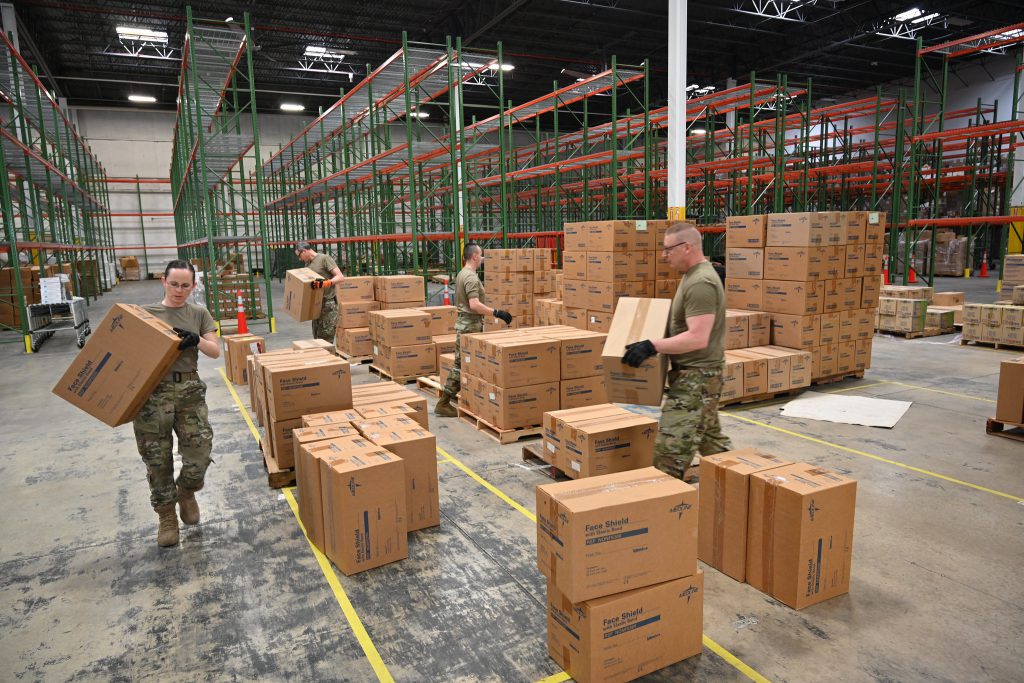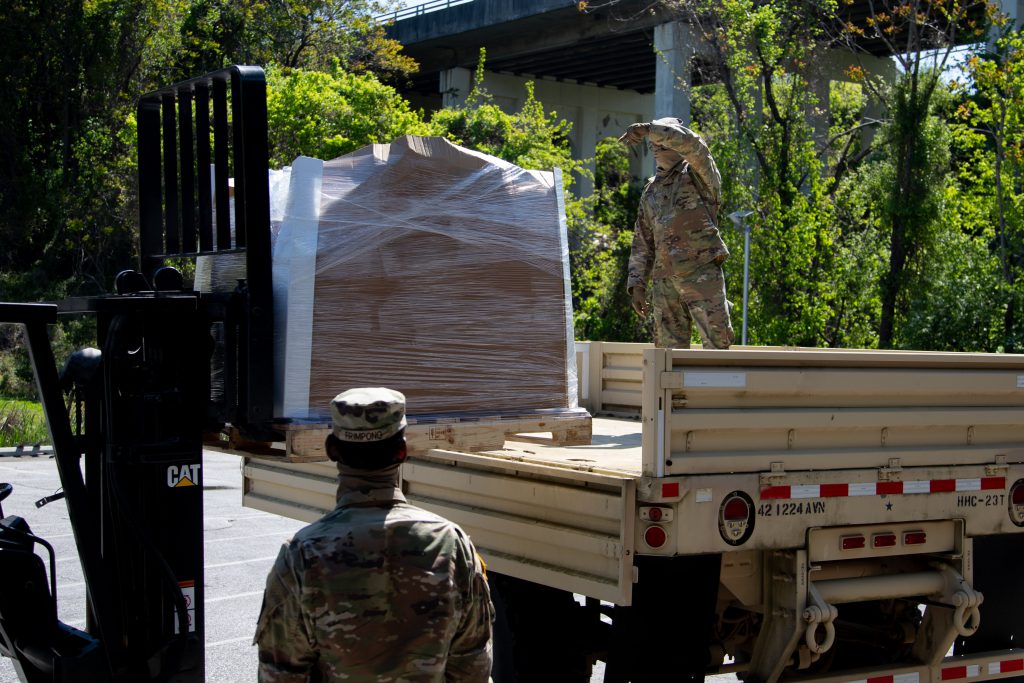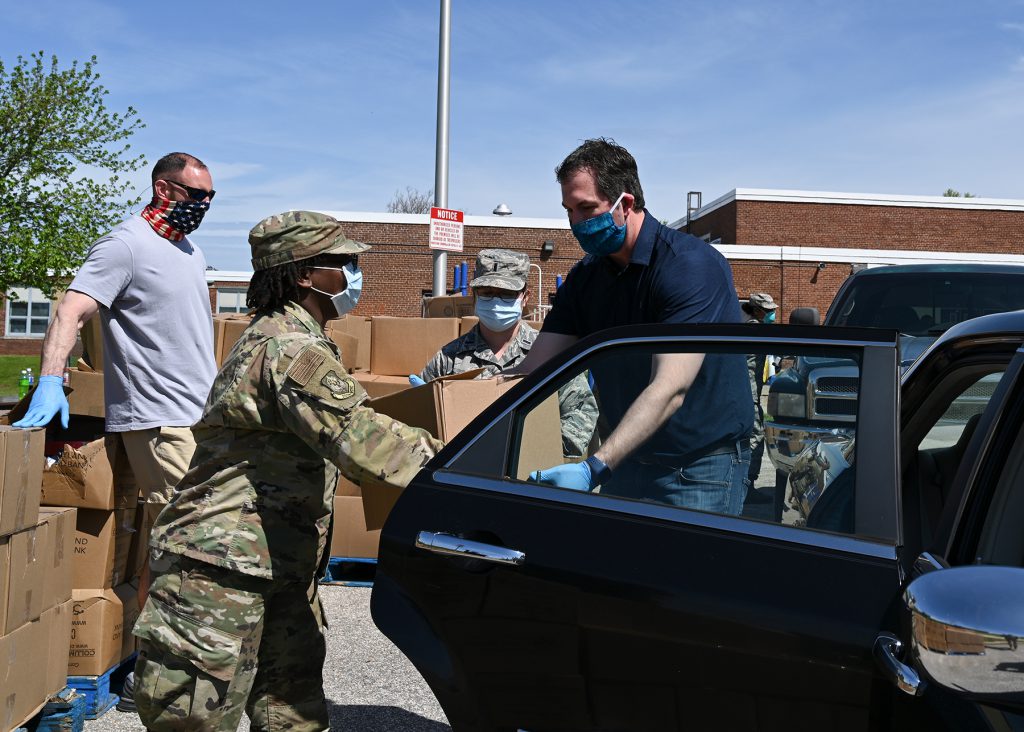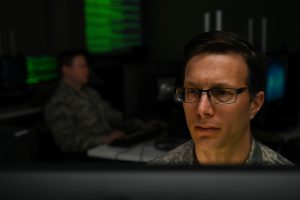In It Together: Maryland National Guard’s Response to the Pandemic
[vc_row][vc_column][vc_video link=”https://www.youtube.com/watch?v=6pOp0QD8ujo” css=”.vc_custom_1598988560867{margin-top: 0px !important;margin-right: 0px !important;margin-bottom: 0px !important;margin-left: 0px !important;border-top-width: 0px !important;border-right-width: 0px !important;border-bottom-width: 0px !important;border-left-width: 0px !important;padding-top: 0px !important;padding-right: 0px !important;padding-bottom: 0px !important;padding-left: 0px !important;}”][vc_column_text css=”.vc_custom_1598355301849{margin-top: 0px !important;margin-right: 0px !important;margin-bottom: 0px !important;margin-left: 0px !important;border-top-width: 0px !important;border-right-width: 0px !important;border-bottom-width: 0px !important;border-left-width: 0px !important;padding-top: 0px !important;padding-right: 0px !important;padding-bottom: 0px !important;padding-left: 0px !important;}”]Maryland National Guard Public Affairs Office[/vc_column_text][vc_column_text css=”.vc_custom_1598357811252{margin-top: 0px !important;margin-right: 0px !important;margin-bottom: 0px !important;margin-left: 0px !important;border-top-width: 0px !important;border-right-width: 0px !important;border-bottom-width: 0px !important;border-left-width: 0px !important;padding-top: 0px !important;padding-right: 0px !important;padding-bottom: 0px !important;padding-left: 0px !important;}”]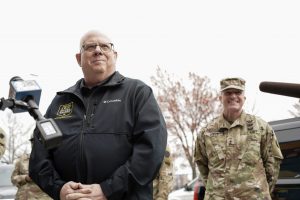
On March 12, 2020, Maryland Governor Larry Hogan signed an executive order activating the Maryland National Guard to assist in the state’s fight against the novel coronavirus. In nearly five months, approximately 1,500 Soldiers and Airmen supported more than 1,300 missions supporting the citizens of Maryland.
The days were long and the needs of the local partners were constantly shifting as COVID-19 spread through the state but the Guardsmen and women were ready to serve however they could.
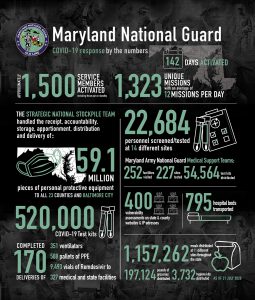 “Our singular purpose is to meet the needs of the people of Maryland and do our part to help keep our communities safe,” said Army Maj. Gen. Timothy E. Gowen, the adjutant general for Maryland. “The Maryland National Guard is focused and prepared to bring every appropriate capability to bear to confront this crisis.”
“Our singular purpose is to meet the needs of the people of Maryland and do our part to help keep our communities safe,” said Army Maj. Gen. Timothy E. Gowen, the adjutant general for Maryland. “The Maryland National Guard is focused and prepared to bring every appropriate capability to bear to confront this crisis.”
The Maryland Guard’s status as a state military force makes it uniquely suited to respond to state-level emergencies whenever needed, in addition to its federal warfighting mission. The brought capabilities like medical augmentation, transportation, food distribution, facility construction, and cyber defense to the state’s response.
Building on relationships forged through years of training, other state of emergencies, and consistent collaboration, MDNG leaders and emergency managers worked closely with Maryland Emergency Management Agency and other civil agencies to determine how they could best support.
The support began with Airmen from the Maryland Air National Guard assisting at a Strategic National Stockpile warehouse. The Strategic National Stockpile is the federal government’s supply of life-saving pharmaceuticals and medical supplies for use in severe public health emergencies that would exhaust local supplies and supply systems. The stockpile, which is maintained by the U.S. Department of Health and Human Services, is stored at key undisclosed locations throughout the United States.
Airmen from 175th Logistics Readiness Squadron processed and distributed more than 59.1 million pieces of personal protective equipment, more than 520,000 COVID-19 test kits, nearly 9,500 vials of remdesivir, and 351 ventilators all over the state. These Airmen also completed 170 deliveries to 327 hospitals, skilled nursing facilities, and medical facilities. By working closely with the Maryland Department of Health, the Maryland Office of Preparedness and Response, as well as other federal partners, they moved supplies and equipment to those who needed it.
“Our Airmen were outstanding and they were able to see the impact of their mission,” said U.S. Air Force Col. Amy Kremser, commander of the 175th Mission Support Group. “We never had a shortage of volunteers because they wanted to be hands-on and to know they were making a difference in their community and with their neighbors.”
The supplies from the Strategic National Stockpile went to those medical professionals serving on the frontlines across the state in all 23 counties and Baltimore City. Soldiers from the 224th Area Support Medical Company, the 104th Area Support Medical Company, the Maryland Medical Detachment and Airmen from the 175th Medical Group provided much needed support in nursing homes and other skilled nursing facilities.
“These [nursing home] missions are very important because these places tend to be a vulnerable population,” said Army Lt. Col. Vincent Reed, a medical support team lead, and aeromedical physician assistant in the 29th Combat Aviation Brigade. “Also, it’s a population of people that have a lot of comorbidities [the simultaneous presence of two chronic diseases or conditions in a patient].”
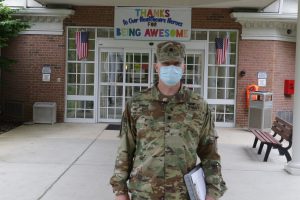 At the behest of the governor, medical support teams were activated to provide assistance to nursing home facilities. The teams, first in the nation to be formed, were composed of members of the National Guard, representatives of local and state health departments, and EMS clinicians, as well as doctors and nurses from local hospital systems.
At the behest of the governor, medical support teams were activated to provide assistance to nursing home facilities. The teams, first in the nation to be formed, were composed of members of the National Guard, representatives of local and state health departments, and EMS clinicians, as well as doctors and nurses from local hospital systems.
The teams, led by civilian medical professionals, helped to identify existing and potential needs and risks. They supported the medical care facilities in their response efforts by providing additional testing of employees and residents and provided additional medical supplies when needed.
“Our goal is to bring medical care for lower urgency conditions to the residents rather than transporting them to emergency departments where they may be exposed to the COVID-19 virus,” said Army Col. Eric Allely, M.D. the Maryland National Guard state surgeon, who was also appointed by the governor as the state’s Emergency Safety and Compliance Officer for nursing homes. “In addition to protecting the residents of these facilities, our efforts help decompress the patient load in emergency rooms and hospitals, opening beds for the growing number of patients in need of those resources.”
The MDNG’s presence has been an integral part to Maryland’s response to COVID-19. The MDNG has made a medical impact by visiting 327 nursing homes and assisted living facilities. Additionally, the team supported 14 sites, which in turn tested more than 22,000 citizens. Also, the MDNG delivered nearly 55,000 test kits to facilities that needed them.
The response effort required establishing 14 testing/screening facilities throughout Maryland communities and coordinating efforts among the various organizations. These sites assisted with the screening and testing of over 22,000 people during the MDNG response.
Soldiers from the 291st Digital Liaison Detachment were charged with the responsibility for providing daily communication and coordination to support civilian partners throughout Maryland. The assigned liaison officers required a diverse set of skills and a broad range of knowledge to successfully establish communication, maintain mutual understanding, and enhance cooperation between the Maryland National Guard and the organizations it supports.
“LNOs protect units from collateral damage, can share tactical and logistical data, and create channels to better effectively respond to national emergencies,” said Army Maj. Christian Maisel, a member of the 291st DLD. “They need to know the capabilities and limitations of the military equipment in the area of responsibility, the partner’s equipment, and local laws and regulations.”
At the FedEx Field temporary screening facility members of the 175th Wing’s Emergency Management Flight aided in communication and command capabilities by providing their Mobile Emergency Operations Center to support the testing and screening facility at the stadium.
“We are here as a joint effort with the 115th Military Police Battalion, to provide interoperability, communications and command support to local and state agencies,” said Air Force Tech. Sgt. Derek White, Emergency Manager assigned to the 175th Emergency Management Flight. “We are able to give them a platform to establish command and control and make sure all the resources and operations that are conducted are done in an efficient manner.”
At Pimlico Race Course and Lake Clifton park, in Baltimore, Maryland, COVID-19 testing sites were established. Soldiers from the 1297th Combat Sustainment Support Battalion which includes the 1729th Maintenance Company and the 1229th Transportation Company setup deployable rapid assembly shelters and medium tents at the locations.
The transportation unit drove nearly 30,000 miles moving hospital beds, supplies, personnel, and facility infrastructure throughout Maryland’s COVID-19 response. They also distributed more than 190,000 box meals in Baltimore alone and delivered 687 pallets of PPE across the state.
Military police Soldiers assisted with traffic control at the first state-sponsored, community-based COVID-19 testing site vehicle emissions sites. Effective communication is necessary for any kind operation, especially with all the different civil agencies involved. These efforts allowed the MDNG to complete 1,323 unique missions, an average of 12 missions per day, over 142 days activated.
Through these uncertain times and financial instability basic necessities become a concern for some. This does not mean people have to go hungry. Members of the MDNG provided assistance to local communities with organizing and distributing meals multiple times a week and groceries monthly. Service members transported boxes of food from food banks to Maryland communities and established food distribution to assist civil agency partners in their efforts to provide relief.
“Our mission is to support our fellow Marylanders,” said Army Pfc. Jerel Jones, an infantryman with C. Co. 1st Battalion, 175th Infantry Regiment, and a step-father of three, distributed meals in the same Baltimore community he resides in.
Jones, like many other service members, supported multiple food distribution sites throughout the state in order to facilitate sanitization, ensure safety guidelines are observed, and foster goodwill between the National Guard and the local community.
Units also prepared and delivered meals to an emergency encampment for the homeless population in Salisbury, people who have been displaced due to the pandemic. Soldiers from three different military police units, all part of the 115th MP Battalion, formed an assembly line in their armory’s kitchen to add the food to the carry-out containers headed to the residents at the encampment, which has been affectionately renamed, Camp Hope.
“Having the National Guard help us feed the [citizens] that are experiencing homelessness is a huge blessing,” said Christine Chestnutt, the housing and homelessness manager for the City of Salisbury. “It is incredible and makes my heart happy.”
Overall, the MDNG distributed more than 1.1 million meals at 56 sites across the state. In addition to meals, 78,174 pounds of groceries and 3,732 hygiene kits were provided to the residents in need.
Cyber
In addition to slowing the spread of the health threat posed by COVID-19, the MDNG was tasked to protect digital infrastructure against anyone attempting to exploit vulnerabilities that impact Maryland communities.
The MDNG was fully prepared to defensively support cyber COVID-19 response efforts. Cyber operations such as defending state and local government networks sometimes fly under the radar. The Joint Task Force Cyber, which is composed of members from the Maryland Army and Air National Guard, Maryland Defense Force, and Maryland Department of Information Technology, were focused on serving their communities by evaluating state and local government websites to ensure they were functioning properly. These websites provided essential information to Marylanders searching for unemployment assistance, updates on COVID-19 relief efforts, or simply how to donate resources.
“We want to make sure the public is getting the most accurate information and that the governor doesn’t have to worry about nefarious activity [disrupting the flow of information to the public],” said Air Force Lt. Col. Colin Ferguson, MDNG Joint Staff Deputy J6 for Cyber.
The MDNG’s cyber protection capabilities have been honed over the years by working alongside their state and local partners.
“They have already done preliminary work in support of the Maryland Emergency Management Agency in the Maryland Joint Operation Center to reduce known vulnerabilities, especially those used by advanced persistent threat actors,” explains Air Force Col. Reid J. Novotny. “It’s easy to hit-the-ground-running because we already knew the people involved and had already set up the command structure between the different organizations in the military and at the state level.”
The Maryland Military Department worked in tandem with local and state organizations to lessen the spread and impact of the COVID-19 pandemic. The MD Mil. Dept. consists of the Maryland Air and Army National Guard, Maryland Defense Force and the Maryland Emergency Management Agency. As a team, the department activated approximately 1,500 service members, completed an average of 9 missions daily for 142 days. Missions included moving 59.1 million pieces of personal protective gear to all 23 Maryland counties plus Baltimore City, distributing over 1 million meals in the community, and assisting with the screening and testing of over 22,000 people over 14 sites across the state.
[/vc_column_text][vc_text_separator title=”View photo gallery from MDNG Response” css=”.vc_custom_1598355329055{margin-top: 5px !important;margin-bottom: 5px !important;border-top-width: 5px !important;border-bottom-width: 5px !important;padding-top: 5px !important;padding-bottom: 5px !important;}”][vc_raw_html css=”.vc_custom_1598355771797{margin-top: 0px !important;margin-right: 0px !important;margin-bottom: 0px !important;margin-left: 0px !important;border-top-width: 0px !important;border-right-width: 0px !important;border-bottom-width: 0px !important;border-left-width: 0px !important;padding-top: 0px !important;padding-right: 0px !important;padding-bottom: 0px !important;padding-left: 0px !important;}”]JTNDYSUyMGRhdGEtZmxpY2tyLWVtYmVkJTNEJTIydHJ1ZSUyMiUyMGRhdGEtaGVhZGVyJTNEJTIydHJ1ZSUyMiUyMGRhdGEtZm9vdGVyJTNEJTIydHJ1ZSUyMiUyMGhyZWYlM0QlMjJodHRwcyUzQSUyRiUyRnd3dy5mbGlja3IuY29tJTJGZ3AlMkZtZG5nJTJGNTJNQzY5JTIyJTIwdGl0bGUlM0QlMjJNRE5HJTIwQ09WSUQtMTklMjBQYW5kZW1pYyUyMFJlc3BvbnNlJTIyJTNFJTNDaW1nJTIwc3JjJTNEJTIyaHR0cHMlM0ElMkYlMkZsaXZlLnN0YXRpY2ZsaWNrci5jb20lMkY2NTUzNSUyRjQ5OTY3ODk5NDYzXzgzNjE4OTUwMzhfei5qcGclMjIlMjB3aWR0aCUzRCUyMjY0MCUyMiUyMGhlaWdodCUzRCUyMjQ4MCUyMiUyMGFsdCUzRCUyMk1ETkclMjBDT1ZJRC0xOSUyMFBhbmRlbWljJTIwUmVzcG9uc2UlMjIlM0UlM0MlMkZhJTNFJTNDc2NyaXB0JTIwYXN5bmMlMjBzcmMlM0QlMjIlMkYlMkZlbWJlZHIuZmxpY2tyLmNvbSUyRmFzc2V0cyUyRmNsaWVudC1jb2RlLmpzJTIyJTIwY2hhcnNldCUzRCUyMnV0Zi04JTIyJTNFJTNDJTJGc2NyaXB0JTNF[/vc_raw_html][/vc_column][/vc_row]

